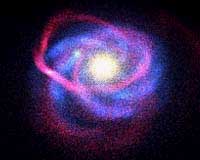 Extraterrestrail type III civilization manipulates the star systems in galaxies. Scientists are finding astonishing evidences with the computer simulation models.
Extraterrestrail type III civilization manipulates the star systems in galaxies. Scientists are finding astonishing evidences with the computer simulation models.Canis Major dwarf galaxy is one of the closest galaxies to the earth. It is colliding with our Milky Way. Our Milky Way is slowly and systematically taking away the stars from the Canis Major which is a much smaller galaxy.
When simulated in a computer it shows very clearly how our Milky Way have systematically taken stars away from Canis Major and grown approximately 1% more in mass at the expense of the smaller galaxy. Simulations show that, over a period of two billion years, the stream of stars lost from the Canis Major dwarf galaxy are able to wrap around the galaxy three times, giving rise to a complex structure which is seen as a immense ring of stars from Earth.
When the data was put in a knowledge base and the inference engine was asked to reverse engineer the model, it clearly showed how two gravitational sources can interact to transfer stars between them. It was absolutely astounding to note that the transfer is totally organized and controlled. The artificial intelligence system allows back calculating the model with which two colliding galaxies have interacted. They do not crash on each other, one is slowly absorbed by the other.
2 comments:
Scientists commonly admit that the distance between solar systems within a given galaxy is sufficiently enormous that when two galaxies "collide", the gravitational systems of those solar systems do not much influence each other. In fact it would be the same as saying that another solar system in our Milky Way is influencing our Sun's system: this is unlikely to happen. The only possibility would be that, e.g., our Sun system exactly crosses a star system pertaining to another galaxy. But, as said, the distance between sun systems is so large that it almost never happens. Just look up in the sky: you barely see our own galaxy, it's so much diluted around. When a crash occurs, colliding planet's effects are almost invisible to an astronomer's eye; we can't even see a single planet in our own galaxy. Only colliding stars provide some interesting firework, and even those do not influence much the appearance of a complete galaxy. Don't expect flashbang fiesta everywhere, better think of some cool "milk in tea" effects.
Keep up the good work » »
Post a Comment